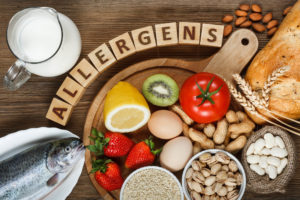Managing Life Threatening Allergies
Food allergy is a serious medical condition affecting up to 15 million people in the United States, including 1 in 13 children. While most allergic reactions are mild, resulting in a rash or hives, some are severe, causing shortness of breath, loss of consciousness and even death. Does your school or parish have a plan to deal with children with allergies?
Educators and religious education coordinators have an important role to play in ensuring the safety of students with allergies, and educating others about the importance of maintaining a safe environment for everyone.

Download RCAB’s guidelines here:
Guidelines for the Management of Life Threatening Food Allergies in the School SettingAfter reviewing the guidelines, if you have any questions, comments, or suggestions, please email us.
What is a Food Allergy?
A food allergy occurs when the immune system mistakenly targets a harmless food protein (an allergen) as a threat and attacks it, causing symptoms that can affect the respiratory system, gastrointestinal tract, skin, and/or cardiovascular system. The first time a person with food allergy is exposed to the food, symptoms may not occur, but the first exposure primes the body to respond the next time. When the person eats the food again, an allergic response can occur. An allergic reaction to food usually takes place within a few minutes to several hours after exposure to the allergen.
Symptoms of Food Allergy
A person may experience all or some of the following symptoms:
- Itching (of any part of the body)
- Swelling of lips and tongue
- GI symptoms, such as vomiting, diarrhea, or abdominal cramps and pain
- Hives
- Worsening of eczema
- Tightening of throat or trouble breathing
- Drop in blood pressure
What is Anaphylaxis?
Anaphylaxis is a potentially life-threatening systemic allergic reaction. Anaphylaxis includes a wide range of symptoms that can occur in many combinations. Some symptoms are not life-threatening, but the most severe restrict breathing and blood circulation.
Symptoms may begin within several minutes to several hours after exposure to the food. Sometimes the symptoms go away, only to return 2 to 4 hours later or even as many as 8 hours later. If a child begins to experience symptoms, you must seek immediate medical attention. Anaphylaxis caused by an allergic reaction to a certain food is highly unpredictable. The severity of a given attack does not predict the severity of subsequent attacks. The response will vary depending on several factors, such as:
- The child’s sensitivity to the food
- How much food the child is exposed to
- How the food entered the child’s body
Most Common Allergens
The eight most common allergenic foods are:
- Milk
- Eggs
- Fish (bass, catfish, cod)
- Crustacean shellfish (crab, lobster, shrimp)
- Tree nuts (almonds, walnuts, pecans)
- Peanuts
- Wheat
- Soybeans
Treatment
Strict avoidance of an allergenic food is the only way to prevent reactions. Early recognition of symptoms and prompt intervention are critical for saving lives. Mild to moderate symptoms are often treated with antihistamines. For patients at risk of severe reactions, the doctor will prescribe epinephrine, the only medication that can reverse the symptoms of anaphylaxis.
Each school and parish religious education program should have an action plan in place to treat children with life-threatening allergies. The Archdiocese of Boston has developed guidelines to help schools develop or refine their plans. The goal of the guidelines are to help schools do the following:
- Provide a safe and health learning environment for all students
- Reduce the occurrence of severe or potentially life-threatening allergic reactions during school hours
- Provide as rapid and effective response as possible in the case of a severe or potentially life-threatening allergic reaction.
Please download the guidelines here:
Guidelines for the Management of Life Threatening Food Allergies in the School SettingBest Practices
- Conduct training for teachers, aids, volunteers, substitutes, and students about food allergies.
- Keep epinephrine accessible. Reactions are never planned. Make sure that staff, substitute teachers, and students know where the epi-pens are stored. Whenever epinephrine is administered, 911 must be immediately called.
- Before distributing snacks, always check food labels for the presence of a prohibited food allergen.
- To avoid exclusion, keep alternate non-perishable allergen-free treats on hand.
- Discourage the use of food allergens for classroom projects/activities as a way to avoid the potential presence of major food allergens. Check all products to be used in craft projects to ensure they are free of any prohibited food allergen. For more information, download Potential Food Allergens in School Activities
- Teach proper handwashing techniques and encourage students to wash hands before and after eating.
- Develop guidelines for food fundraisers,such as bake sales and candy sales, that are held on school grounds.
- Discourage students from trading or sharing food, drinks, straws, or utensils with others.
- Educate cafeteria staff and monitors about food-allergy management and make them aware of students who have life-threatening food allergies.
For more information on training food safety workers in allergen awareness, please see the Massachusetts Allergen Training page on ServSafe’s website.

